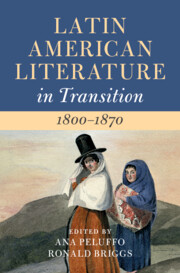Book contents
- Latin American Literature in Transition 1800–1870
- Latin American Literature in Transition
- Latin American Literature in Transition 1800–1870
- Copyright page
- Contents
- Figures
- Contributors
- Acknowledgments
- Introduction
- Part I Aesthetics of Disorder
- Part II Affective Communities
- Part III Intersectional Subjectivities
- Chapter 15 Shame, Enslavement, and Identity
- Chapter 16 Narratives from Enslavement
- Chapter 17 Masculinities and Racial Ambivalence
- Chapter 18 Childhood, Race, and Gender
- Chapter 19 Uncle Tom’s Cabin in Brazil
- Part IV Transoceanic Consciousness
- Index
- References
Chapter 15 - Shame, Enslavement, and Identity
from Part III - Intersectional Subjectivities
Published online by Cambridge University Press: 24 January 2023
- Latin American Literature in Transition 1800–1870
- Latin American Literature in Transition
- Latin American Literature in Transition 1800–1870
- Copyright page
- Contents
- Figures
- Contributors
- Acknowledgments
- Introduction
- Part I Aesthetics of Disorder
- Part II Affective Communities
- Part III Intersectional Subjectivities
- Chapter 15 Shame, Enslavement, and Identity
- Chapter 16 Narratives from Enslavement
- Chapter 17 Masculinities and Racial Ambivalence
- Chapter 18 Childhood, Race, and Gender
- Chapter 19 Uncle Tom’s Cabin in Brazil
- Part IV Transoceanic Consciousness
- Index
- References
Summary
In this chapter I engage in a comparative analysis of discourses of shame and identity in the Cuban and US slave systems, which were interrelated economically yet differed in terms of public discussions of race and affect (Chambers 24). Without conflating these systems or overstating their differences, I hope to understand the relationships connecting discussions of race, affect, practices of rule, and slaveholder paternalism – the notion of reciprocal duties that allegedly bound slaveholders and slaves together – in legal, literary, and political discourse (Genovese 5).
- Type
- Chapter
- Information
- Latin American Literature in Transition 1800–1870 , pp. 237 - 251Publisher: Cambridge University PressPrint publication year: 2022



